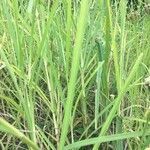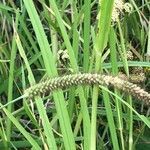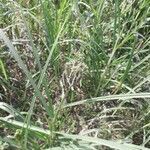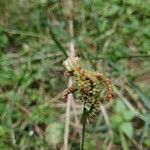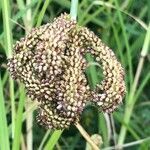Tufted annual, 210-620 mm high; culm moderately robust, geniculately ascending, frequently rooting at lower nodes. Leaf blade 220-500 x 6-10 mm; ligule a fringed membrane. Inflorescence subdigitate; 3-13 racemes, 60-170 x 4-10 mm, slender. Spikelet 5-8 x 3-4 mm, awnless; lower glume acute, 2-or 3-nerved; upper glume 3.0-4.7 mm long, acute. Florets 2-6; lemma 3.5-5.0 mm long, apex acute to subacute, keel scabrid; palea keels scabrid along wings; anther 0.5-1.0 mm long. Flowering time Oct.-May. Caryopsis oblong, uniformly glandular, obliquely ridged.
A millet grass. It is an annual grass. It is robust and forms many tillers or young shoots from the base. It grows 40-120 cm tall. The stems are somewhat flattened. The leaves are narrow. The flower heads are made up of 2-7 finger like spikes. These spikes are 1.5 cm across and 10-15 cm long. These in turn have about 70 smaller spikes. Each one of these smaller spikes has 4-7 seeds. The seeds can be 1-2 mm across. The seeds are roughly rounded. The colour varies. There are coracana and africana subsp.
Tough, shiny annual, up to 0.62 m tall. Leaves linear, usually folded; ligule a fringed membrane. Inflorescence of 3-13 one-sided racemes digitately-or subdigitately arranged. Spikelets 4.6-7.8 mm long, laterally compressed, many-flowered, glabrous, awnless; glumes unequal, shorter than spikelet.
Annual to 60 cm. Leaves linear, often folded. Spikelets in 3-13, digitately arranged, secund spikes, 5-8 mm long.
